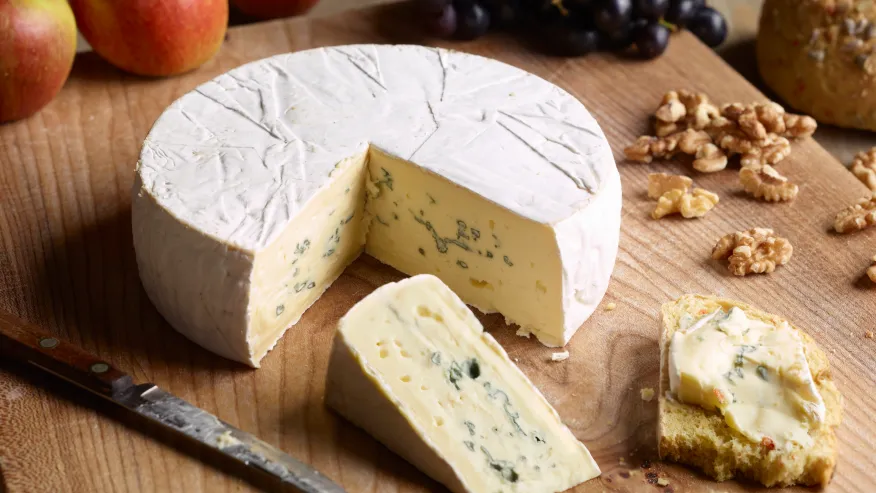Camembert

Camembert
Camembert is a moist, soft, creamy, surface-ripened cow’s milk cheese. It was first made in the late 18th century in Camembert, Normandy, in northwest France. It is sometimes compared in look and taste to brie cheese, albeit with a slightly lower butterfat content than brie’s typically 20% – 25% by weight. Wikipedia
Region of origin: Camembert, Lower Normandy
Nutrition FactsCamembert cheese
Camembert cheese
Sources include: USDA
| Amount Per 1 cubic inch (17 g)1 oz (28.4 g)1 wedge (1.33 oz) (38 g)100 grams1 cup (246 g)100 grams |
| Calories 299 |
| % Daily Value* | |
| Total Fat 24 g | 36% |
| Saturated fat 15 g | 75% |
| Cholesterol 72 mg | 24% |
| Sodium 842 mg | 35% |
| Potassium 187 mg | 5% |
| Total Carbohydrate 0.5 g | 0% |
| Dietary fiber 0 g | 0% |
| Sugar 0.5 g | |
| Protein 20 g | 40% |
| Vitamin C | 0% | Calcium | 38% |
| Iron | 1% | Vitamin D | 4% |
| Vitamin B6 | 10% | Cobalamin | 21% |
| Magnesium | 5% |
| *Per cent Daily Values are based on a 2,000 calorie diet. Your daily values may be higher or lower depending on your calorie needs. |
Brie, camembert among French cheeses at risk of extinction
- Some of France’s beloved cheeses risk extinction
- Scientists alarmed as key cheese fungus dwindles
- Fungst struggle with reproduction, scientists say
(NewsNation) — Some French cheeses, including Brie and camembert, are at risk of disappearing due to a collapse of bacterium needed to produce them, according to France’s National Center for Scientific Research (CNRS).
Concerns were raised in January after scientists at Paris-Saclay released a study identifying penicillium camemberti, the main fungus used in creating camembert and other cheeses, was increasingly in short supply due to industrial production methods.Over 35,000 pounds of Johnsonville sausage recalled
Penicillium camemberti, which is also the main strain of fungi that France’s biggest cheesemakers rely on, is experiencing problems reproducing, scientists said. They note the problem is largely a result of the pressures of industrial production and isn’t performance anxiety per se.
Cheeses like camembert and Brie were previously aged in caves where naturally occurring mold spores gave them blue or sometimes yellow-brown rinds, the study said.
However, penicillium camemberti has been favored since the late 1800s, replacing the indigenous mold, because it creates the cheese’s signature uniform white rinds. Other strains produce greys, oranges and greens tinges with distinct flavor profiles, according to CNRS.Walmart weighted groceries settlement: Will you qualify?
The study reveals that, unlike cave dwellings, penicillium camemberti has a low genetic diversity and declined capacity to reproduce sexually.
Our findings raise questions about the use of limited number of clonal strains for cheese making, which tends to lead to degeneration, limiting the possibilities for further improvement,” the study said.
CNRS explained the meaning further, stating, “It is now very difficult for manufacturers to obtain sufficient quantities of P. camemberti spores to inoculate their Normandy cheese production.”







